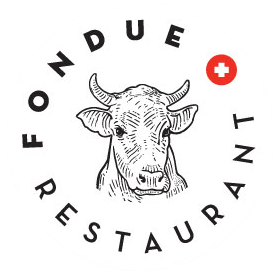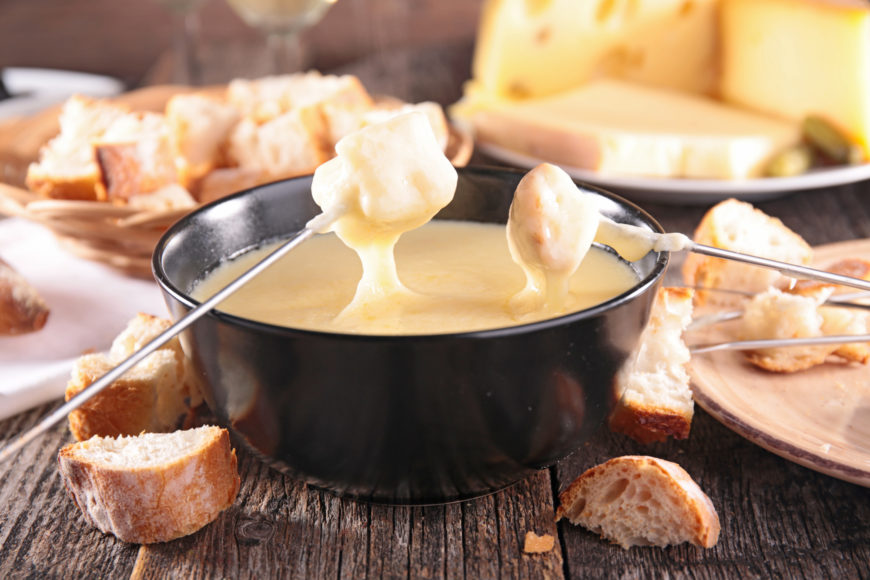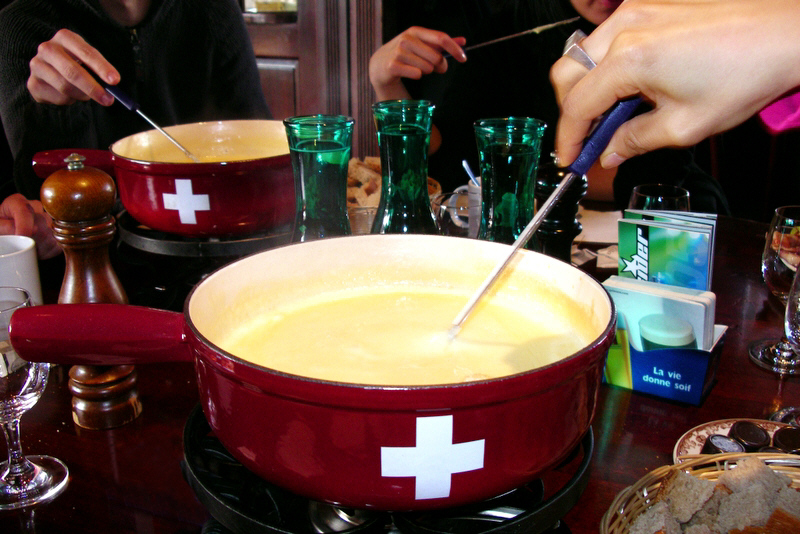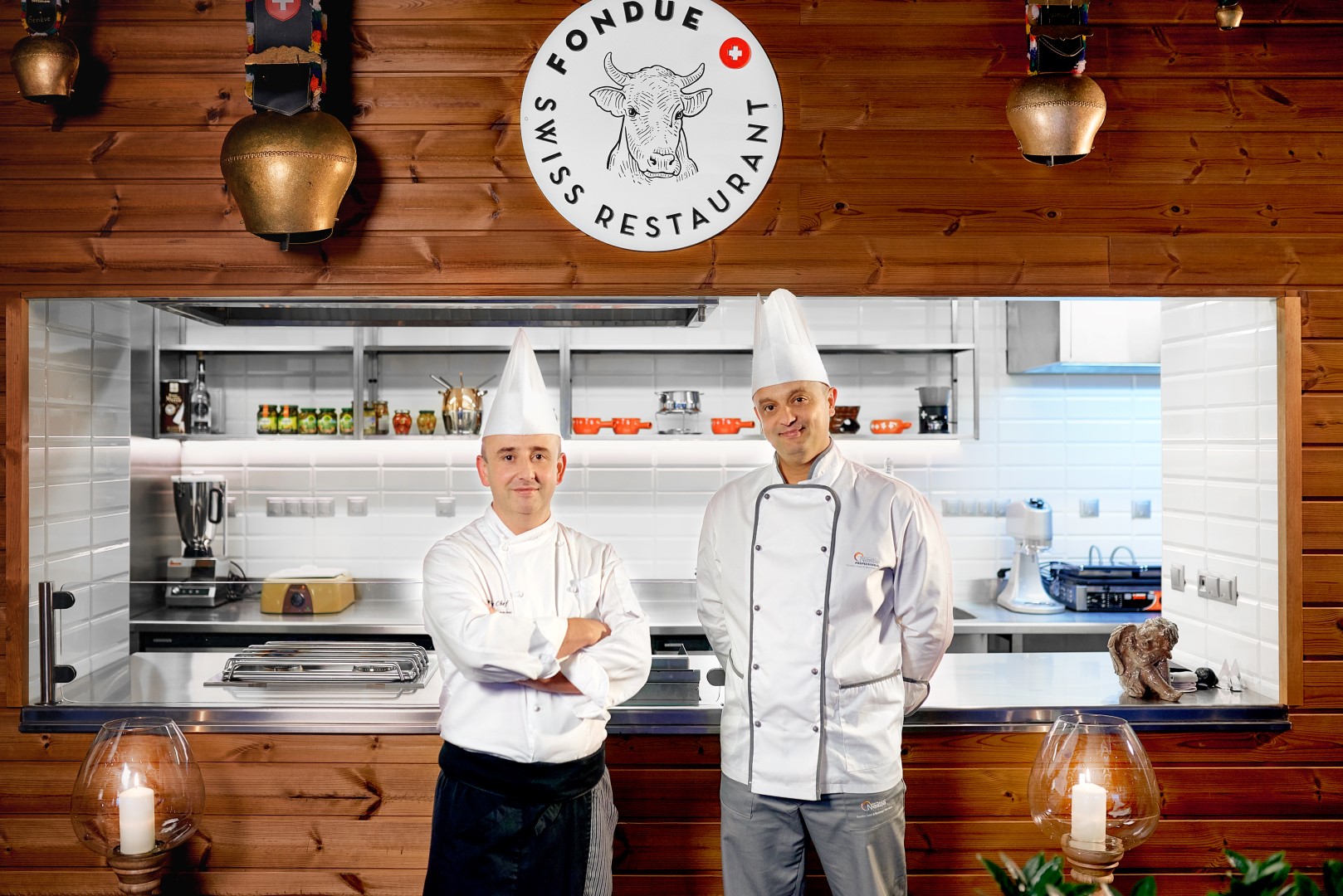Fondue is known as one of Switzerland’s national meals, but in fact this delicious dish mad out of melted cheese is made not only in Switzerland, but also in the Alpine regions of Italy (Piedmont and Valle d’Aosta) and France (Savoy).
History in brief…
The origin of the meal is lost in legends, and we cannot be sure about how exactly it was invented, but we can at least mention two of the most popular legends for the origin of fondue.
According one of the legends, Swiss shepherds who ran out of hot meal up in the mountains, tried to warm some cheese so they could dip dried bread in it. Other legend says that fondue was invented in the 13th century by the Swiss monk Vacarinus as a way to avoid the strict abstention of cheese during the Great lent.
We’ll probably never know for sure who invented fondue, but at least we have the date of the first written evidence of its existence. We owe that to the French politician Jean Anthelme Brillat-Savarin who in 1825 described a meal made of melted cheese, eggs and butter.
The discussions regarding the home country of the recipe for making a melted cheese dish are still ongoing, but the truth is that the traditional fondue in its basic version is made in a special cast iron or clay pot (caquelon), where different types of cheese are melted (varying depending on the region). The dish is prepared on low heat and consumed hot straight from the dish by dipping pieces of bread in it.
So, what is the difference between the Swiss, Italian and French Fondue menu?
Switzerland
Only Swiss cheese is used to prepare the classic Swiss fondue. Depending on the different region of the country, the cheese combination may vary, but the classic is fondue with two varieties – Emmental and Gruyère, or three varieties – Appenzeller, Emmental and Gruyère.
It is essential that the used cheese is firm and preferably non-ripened. The Swiss add some corn, rice or potato starch to achieve better density and smoothness.
The classic Swiss fondue cannot be made without kirsch (cherry liqueur) or dry white wine. If wine is used it must be of good quality and suitable acidity. Such wines are Sauvignon Blanc, Pinot Blanc, Erbaluce di Caluso.
If you are in the mood of classic Swiss fondue, you are welcome to try the specialties offered in some Bansko restaurants.
France
The French fondue recipes have some differences amongst themselves, because every region here also uses different cheese varieties for its fondue menu. One of the most popular recipes comes from the region of Franche-Comté, where fondue is made only using one type of cheese Mont d’Or (seasonal cheese produced in the region of Jura between August and March).
Among popular recipes is also the Savoyarde fondue made with Gruyère, Comté and Beaufort.
Ramequin is a fondue specific for the commune of Saint-Rambert-en-Bugey. It’s made using only one cheese variety – Ramequin, melted in the caquelon with butter and a bit of water, just enough to get the right consistency.
The Norman fondue is made of interesting set of cheeses. Unlike other recipes where firm cheese is used, Norman is prepared using soft cheeses such as Camembert, Pont – l’Evêque and Livarot.
Some fondue recipes from the French Alps (and Switzerland) require that the caquelon is rubbed with garlic and include wine and butter.
Italy
Fonduta is a specialty from Piedmont and Valle d’Aosta. It is made with one cheese variety – La Fontina – semi-firm cheese from whole fat milk. Depending on the period when the cheese is produced, its taste varies depending on the cattle feed for the animals that gave the milk for it. The taste of La Fontina is similar to the Swiss Emmental and Gruyère cheeses, but it melts like Mozzarella.
The main difference between the Swiss, French and Italian fondue menu is that Italian recipes do not include wine, garlic or thickener (starch). Instead, fondue is made with butter, milk and egg yolks. Some white Cayenne pepper or white truffles also can be added.
Classic recipes for Swiss, French and Italian fondue menu
Swiss recipe
- 250 gr. Gruyère
- 250 gr. Emmental
- 350 ml. dry white wine or kirsch
- ½ clove
- garlic
- 4 tbsp. corn starch
- 1 tbsp. lemon juice
- Ground black pepper, nutmeg
- 6/8 slices of bread
- butter
The cheese is separated from its crust, chopped and left aside. The slices of bread are toasted and chopped to bite size.
Rub the caquelon’s inside thoroughly with garlic and place butter inside. After it melts, add 1/3 of the kirsch (wine) together with the lemon juice. Gradually add the cheese chops and don’t stop stirring the mixture with a spoon.
Stir the fondue until all the cheese melts into a creamy mixture. Dissolve the starch in the remaining kirsch (wine) and gradually add it to the melted cheese. At the end sprinkle the nutmeg, clove (optional) and the black pepper. Stir.
Place the finished fondue on the table in the pot where it was made and eat warm.
Italian fondue – Fonduta Valdostana
- 400 gr. Fontina cheese
- 40 gr. butter
- 4 egg yolks
- 200 ml. milk
- White truffle
- White pepper
- Slices of whole wheat bread
Remove the crust of the Fontina cheese and cut it into cubes. Put it in a bowl and pour the milk over it (the milk should completely cover the cheese). Set it aside for at least an hour. After that transfer the chees in the cooking pot. Add the chopped butter and stir until everything melts.
When the mixture becomes creamy, add yolks one at a time. (Be careful when adding yolks – add one, stir vigorously for 2-3 minutes and then add the next one.) After all yolks are added, pour in the milk in which the cheese was soaked.
Finally, add salt (if necessary) and white pepper. Just before serving it add thinly sliced white truffle on top (optional).
Fonduta Valdostana may be consumed from the pot it was made or you may serve it in separate bowls. (If served in bowls it is eaten with a spoon). The bread used for dipping in the fondue is usually whole wheat, but may be replaced with white bread.
Classic French fondue Savoyarde
- 200 gr. Comté or Gruyère cheese
- 200 gr. Emmental
- 200 gr. Beaufort
- 300 ml. dry white wine
- 1 garlic clove
- Nutmeg
- 1 tbsp. (corn) starch
- 1 cup kirsch
- White pepper
Cut the cheese into cubes. Rub thoroughly the inside of the caquelon with the peeled garlic. Pour 250 ml. of the wine in the fondue cooking pot, and use the rest to mix with the nutmeg and the starch.
When the wine is hot enough, add the cheese cubes and stir until the mixture homogenizes. Finally, add the kirsch and the white pepper.
Where can you try these recipes in Bulgaria?
There are a few places in Bulgaria where you can have varied fondue menu, and if you are coming to Bansko, you should visit one of Bansko’s restaurants, where you will enjoy some great dishes straight from French, Italian and Swiss cuisine.


![[:bg]Оригинално швейцарско фондю | Ресторант Фондю[:en]Original Swiss fondue | Restaurant Fondue[:]](https://fondue.bg/wp-content/uploads/2018/01/original-swiss-fondue-cover.jpg)



